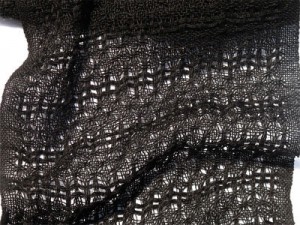I really enjoy learning. New techniques, new processes, new ideas – I find them all exciting. I also like to push the envelope – to make the limited tools and skills I have do something that is supposedly beyond their capacity. I think that’s the teenager in me: tell me that I can’t do something, and my reaction is, “Wanna bet? Just watch me!” Not necessarily a mature reaction, but it is one that has served me well often enough that I haven’t tried to squash it.
After years of thinking that I wasn’t either interested in or able to weave lace patterns on my counterbalance loom, I finally decided I’d give it a try. I couldn’t have done that without having gone through several experiential processes.
I had to work with fine yarn – in my case 5/2 Egyptian cotton, rayon, and pearl cotton – to learn that I like it, that it has relevance to my weaving, and that its properties are appealing.
I had to learn to do the doubleweave, and do it on my loom, to learn that my sweet, old, counterbalance loom could do unbalanced weaves (1 harness up and 3 down versus the 2 up and 2 down that is counterbalance’s diet of choice).
Then I had to stumble on a pattern that I liked, and directions that gave me clues about what types of yarn it would work well with.

Huck Lace Scarf
I found weaving the lace to be interesting and full of surprises. First off, it was the first time I’d worked with solid black. This was a challenge in and of itself. It’s not easy to see what you’re doing, at least on my loom, with black. Then, while you’re weaving, the fabric bears little resemblance to the finished product. The lacy effect is pretty much invisible. You can see some unusual patterns on the loom, but you’d never know that it would turn into lace.
Take it off the loom and finish it (wash it with an appropriate amount of agitation), and VOILA – the cotton slides around itself to create lovely lace!
I’m looking forward to weaving more lace scarves in this and other patterns and colors. I don’t have any up on my website yet, so contact me to get a lace scarf now, during the warmth of summer.


I am wanting to use a left over warp on my 4 shed loom that is threaded TWILL (1,2,3,4). I was thinking making some evening bags. They would be oblong. The warp is only about 4 inches wide. It’s in a rose color. I am having problems with the matalic thread I have due to how thin it is. You really can’t see a pattern due to the matalic thread. It is as thin as the warp and the silver dominates. I saw in my head that a twill pattern over the rose would show the diagonal lines of silver on the rose. Maybe I can find a thicker matalic thread but I don’t know. I tries double thread not much difference. Maybe use a different treadling of a twill. Suggestions?
Karen –
I’ve never used metallic threads, so I don’t really have any experience to offer you, but I wonder how the metallic threads will hold up in the long run. Would it help both weave pattern, look, and longevity of the woven piece if you used two different threads, one metallic and one not?
I have a 4 harness counterbalance loom. How do I make of the most of tying up the 4 harness? I have only done 1-3 and 2-4 or retying with 1-2 and 3-4. Am I missing something in making the most of tying up? Thanks……Jan
Jan – The answer to your questions start with one of my own — how many treadles does your loom have? If you have the standard 6 treadles for a 4-harness, I started with tabby, just like you, using treadles 5 & 6 every time. I made a number of scarves simply using that tabby weave.
Then I tied up treadles 1 through 4 like this: 1-2, 2-3, 3-4, 4-1. I could do some wonderful twill variations with those treadlings, depending on how I threaded my heddles. I wove lots more pieces using various twills: straight twill, point twill, diamond twill, and lots more.
Once I felt confident in those weaves, I decided I wanted to try some lace weaves. Most things that I read said that you really couldn’t do lace weaves on a counterbalance loom, because lace weaves require lifting 1 harness at a time, and counterbalance looms are made to lift 2 harnesses at a time, keeping everything in an equal balance. Well, I’m a stubborn sort, and wasn’t going to give up that easily. I did a bunch of research. I learned that LeClerc makes something called a shed regulator for their counterbalance looms. I looked at pictures of them online to figure out how they worked. I was not willing to even consider making structural changes to my lovely handmade loom that using a LeClerc shed regulator would mean, so if I wanted to do it, I had to find another way. In my case, that meant moving all four of my harnesses closer to the top of the loom. How? I shortened the Texsolv tieups that connect my two roller bars to the top roller bar. Shorter tieups move everything up. Moving everything up allows me to get an acceptable shed when I raise just one harness at a time (or when I raise 3 at a time). The shed is not as big as when I do a balanced (2 against 2) treadling, but I can get a shuttle through it without difficulty.
How did I get to that point and realization? Practice, experience, and a willingness to try things that might fail miserably. I had to be really comfortable that I understood fully how my loom worked, so that I could pretty easily move things around, and very confident in my ability to do a variety of twill weave structures before I could even think about it. In my experience, weaving, like many things, is an ongoing learning process. Every new technique I learn builds on the skills I already have. Many of the things I am able to do now, I couldn’t have considered till I’d done plenty of simpler things (lots of plain weave and twill weave). And trust me, I have DECADES of process and technique to learn. One threading of the heddles at a time, one throw of the shuttle at a time, one warp at a time.
Good luck, and let me know if I can be of further help.
[…] learning how to make lace on my beloved, handmade counterbalance loom, I made handwoven lace scarves in several colors […]
[…] So what was the hot weaving item at Elmwood? I sold all three lace scarves I had, and got orders for three more. I had two other orders prior to leaving, so I really need to make lace. I just received the 5 colors of 10/2 pearl cotton I ordered for them. I’m so glad I figured out how to do make handwoven lace on my little counterbalance loom! […]
Thanks, Linda. I am impressed with your bravery in assembling your new loom – WOW! Is the Kessenich a borrowed loom and now the Julia is owned, or do you own both?
You’ve inspired me. I just put together my Julia, 4 harness/4 treadle counterbalance loom and I was looking for projects. You’re lace is amazing. I don’t expect to try something so adventuresome on my first outing…but at some point, yes. Like you, I love the challenge and adventure of acquiring new skills.
Tropical Twister
http://Seabreezespinners.com